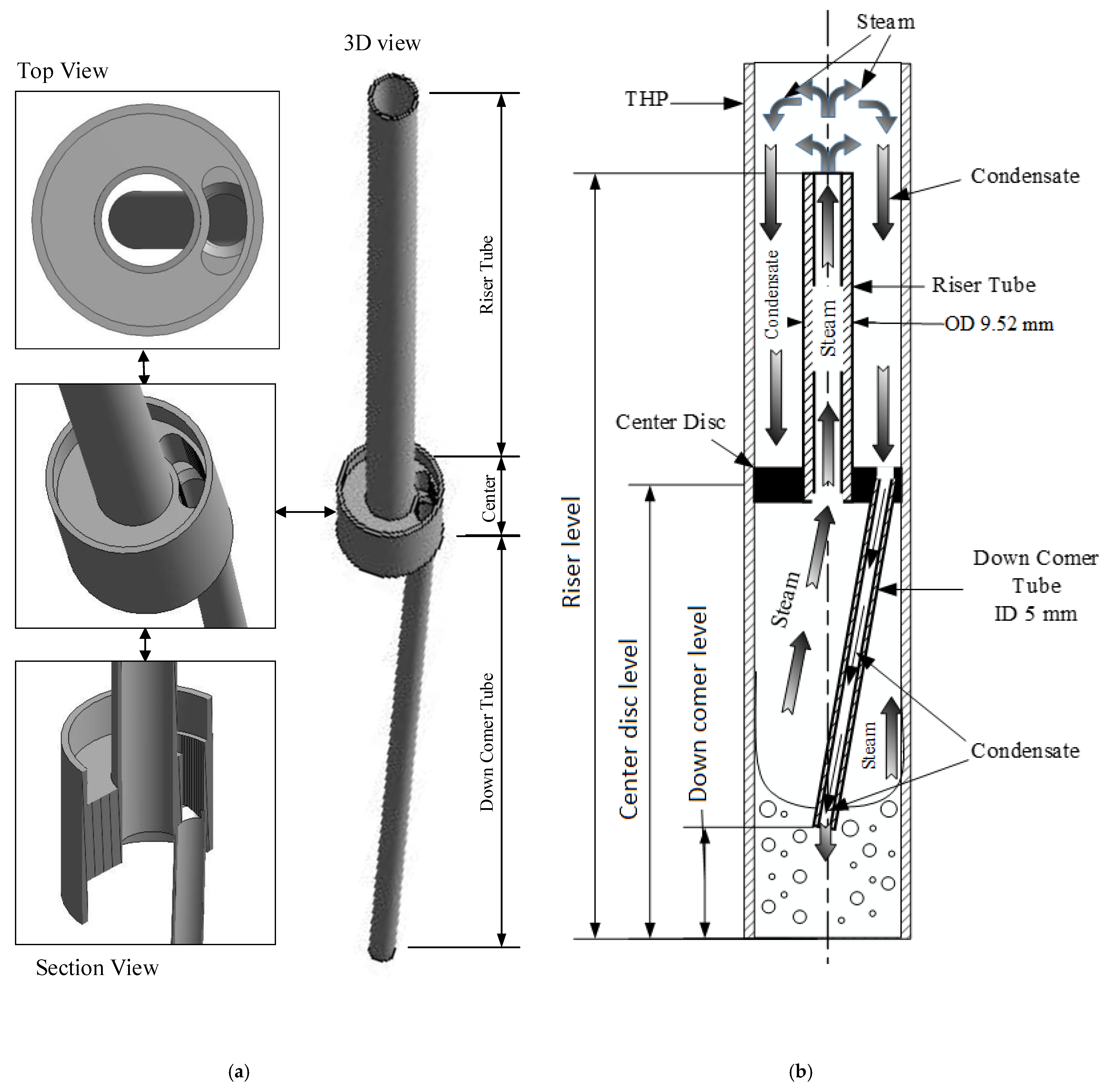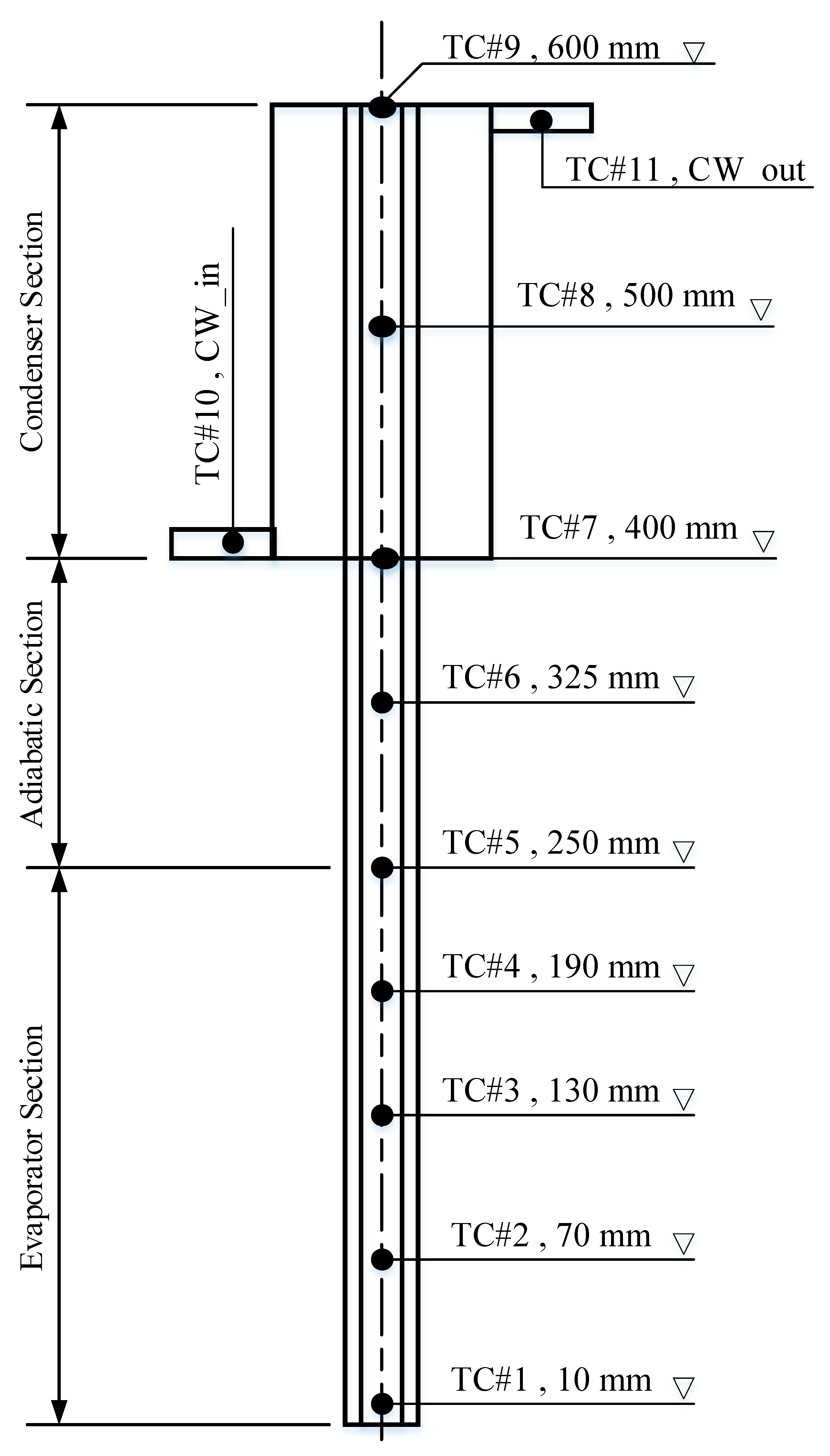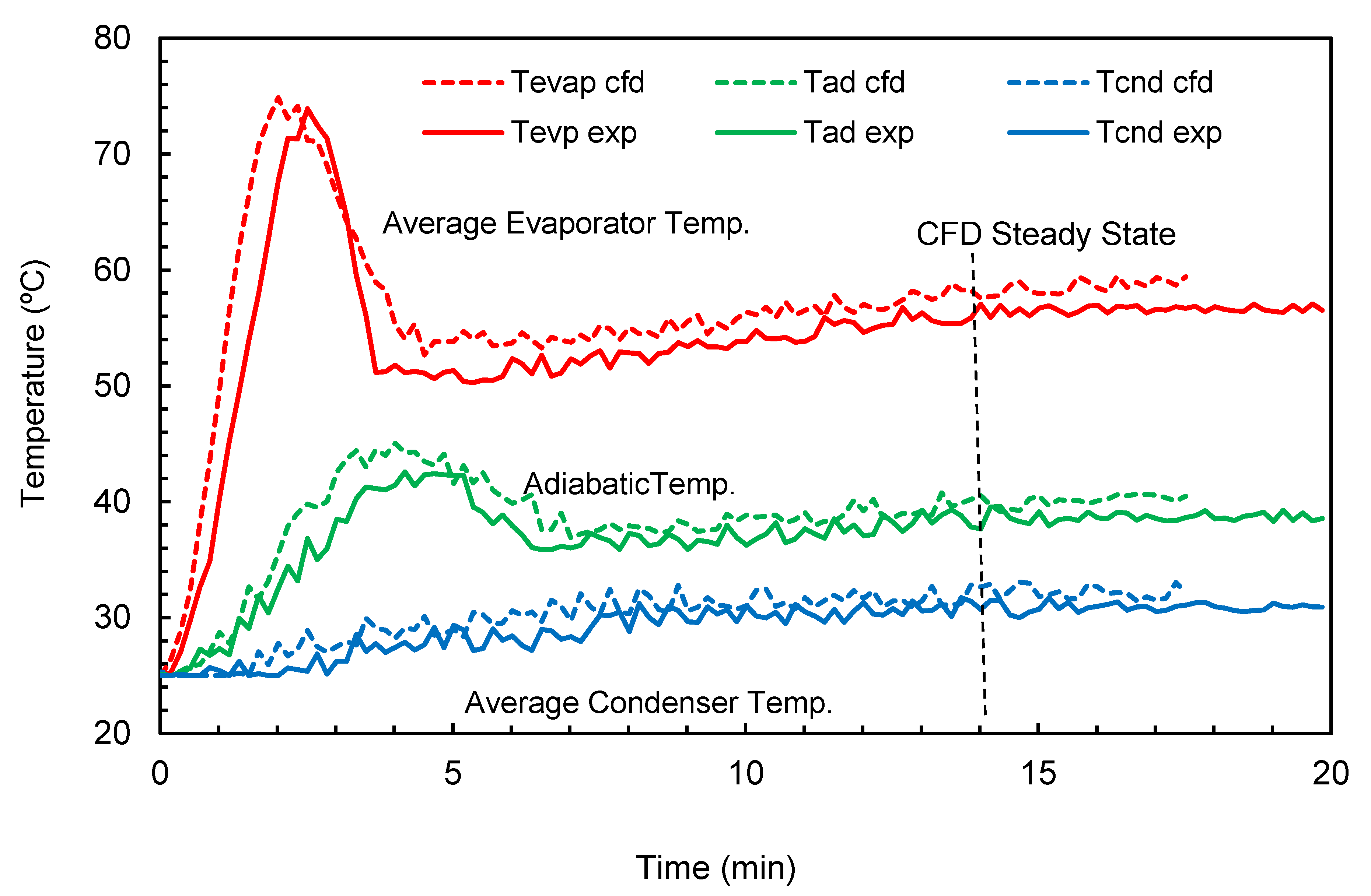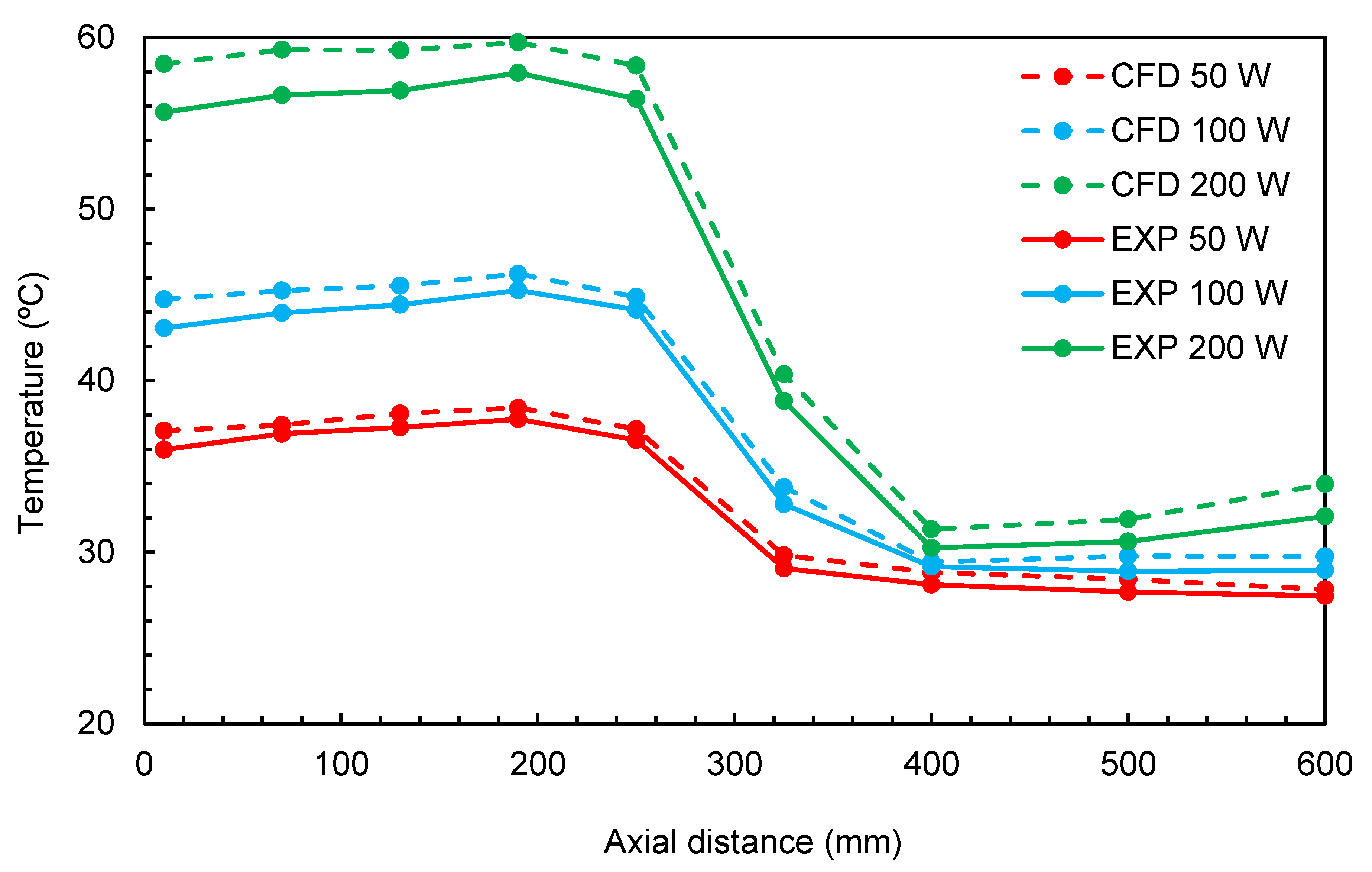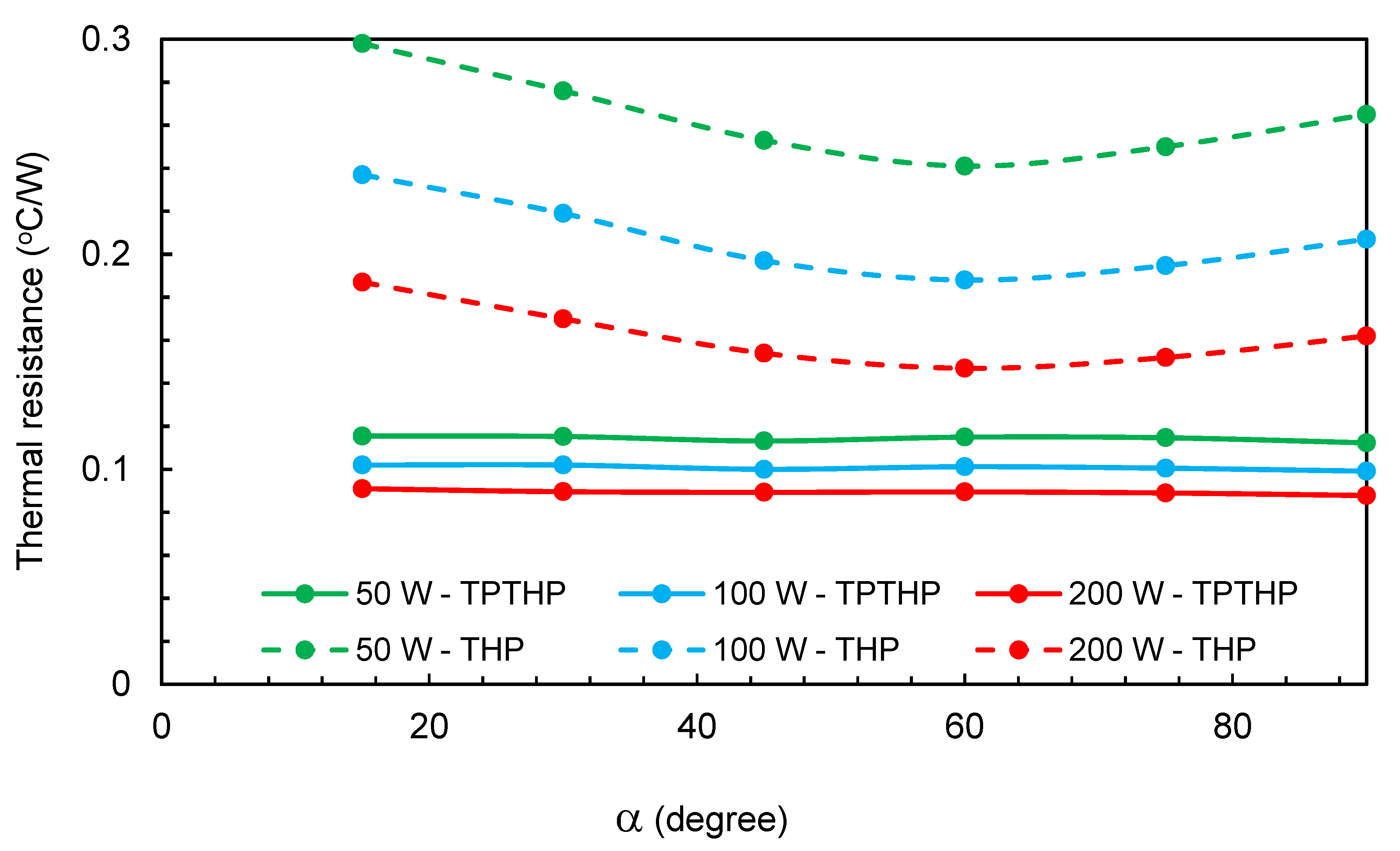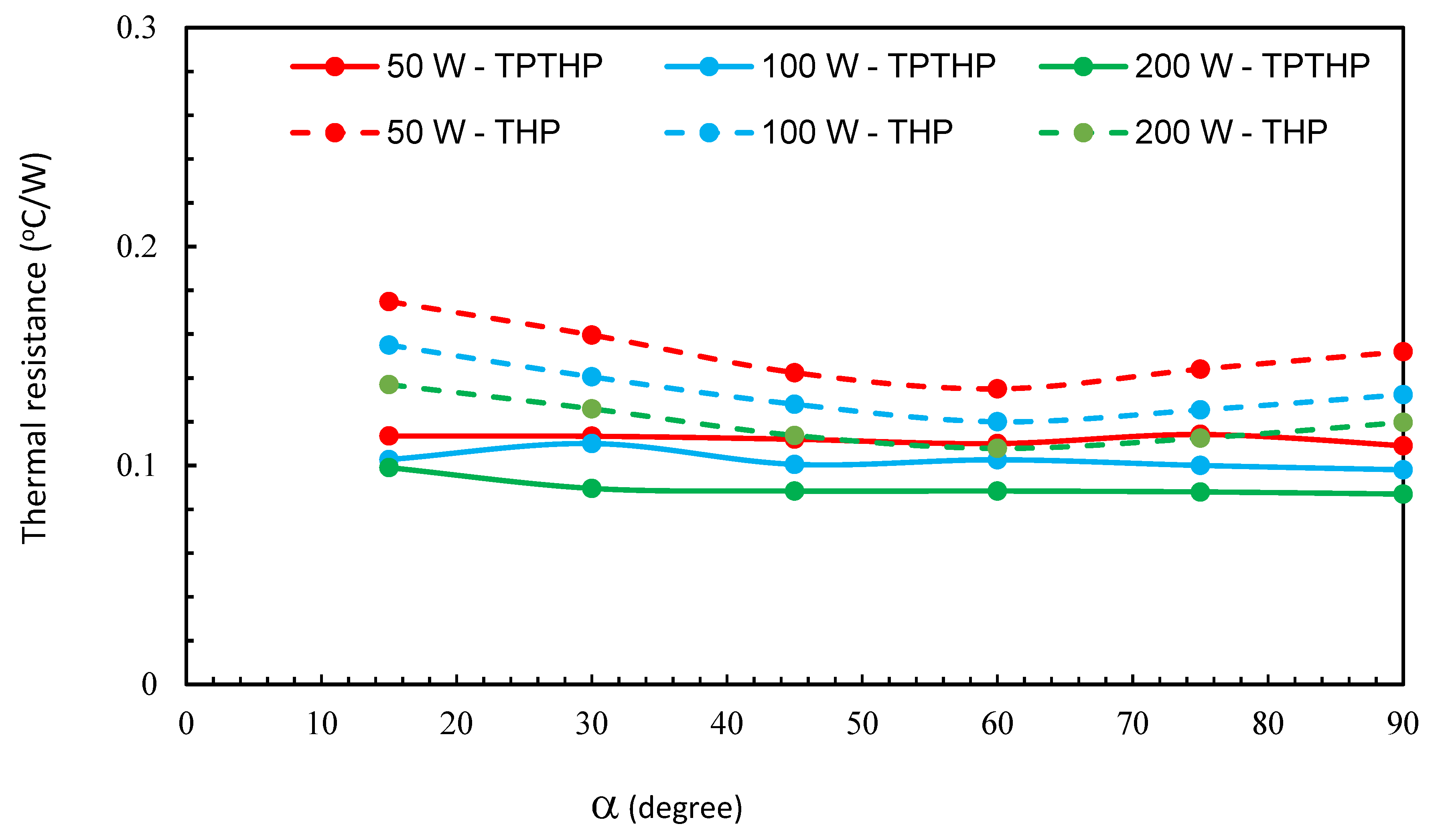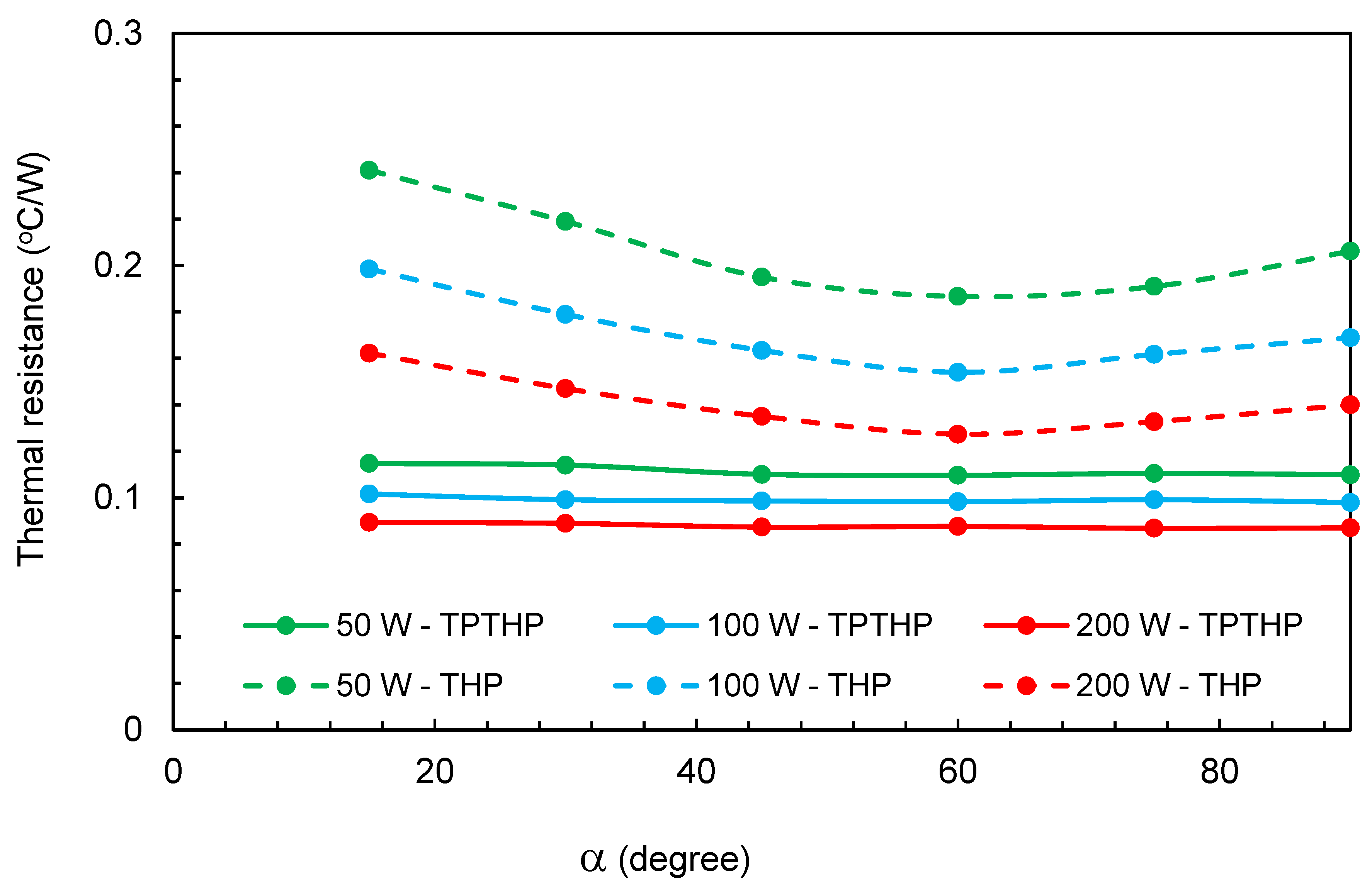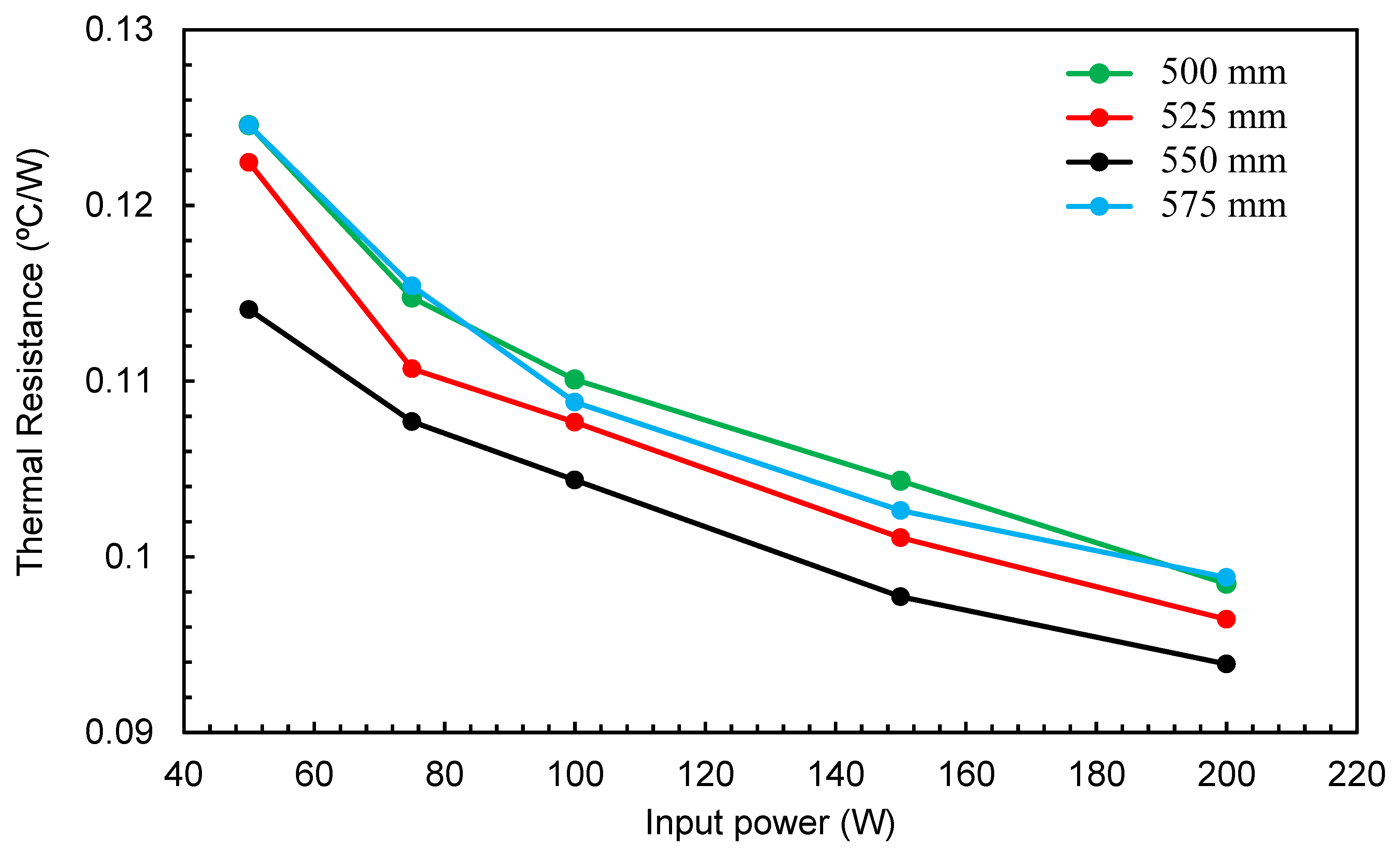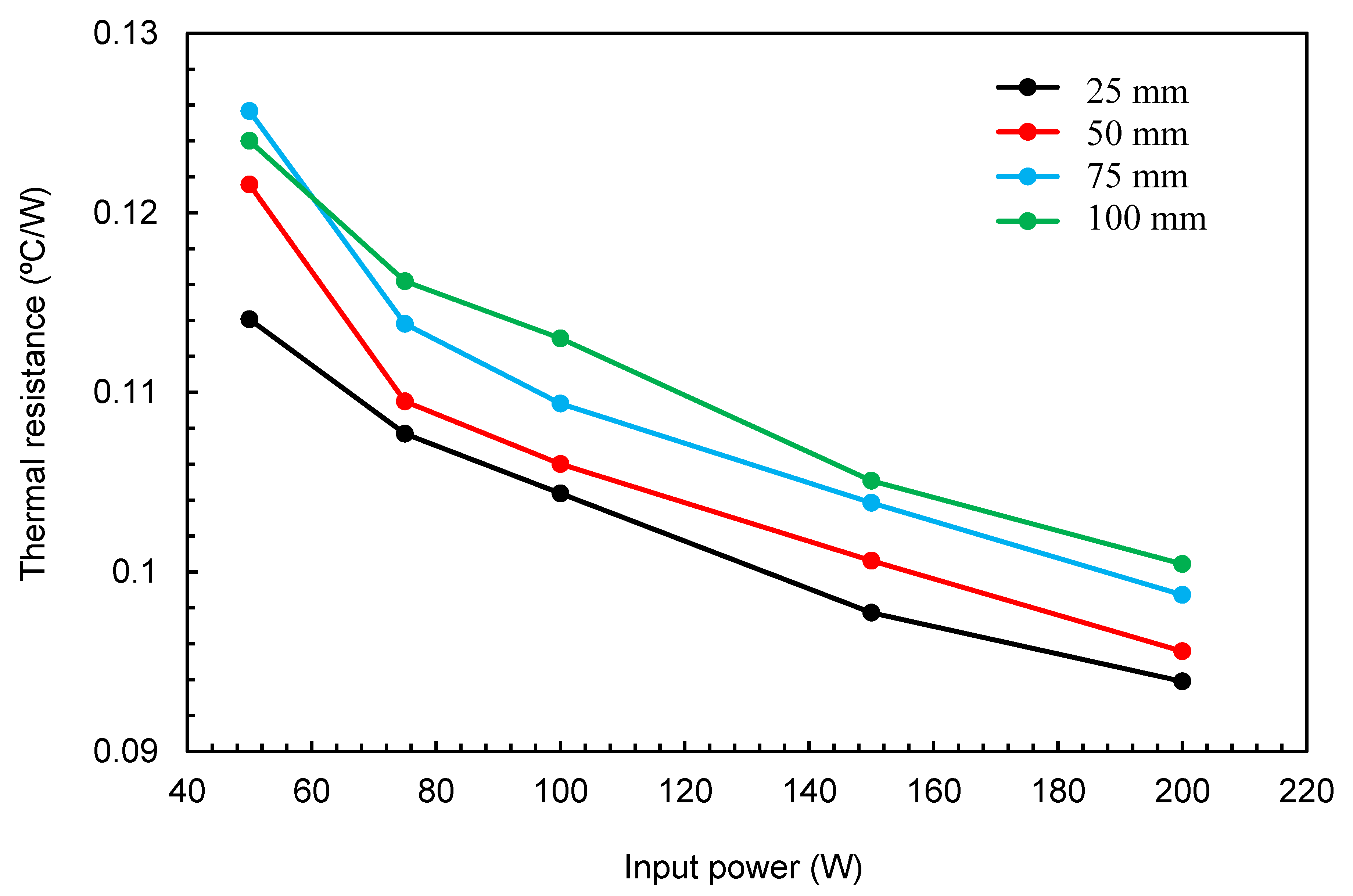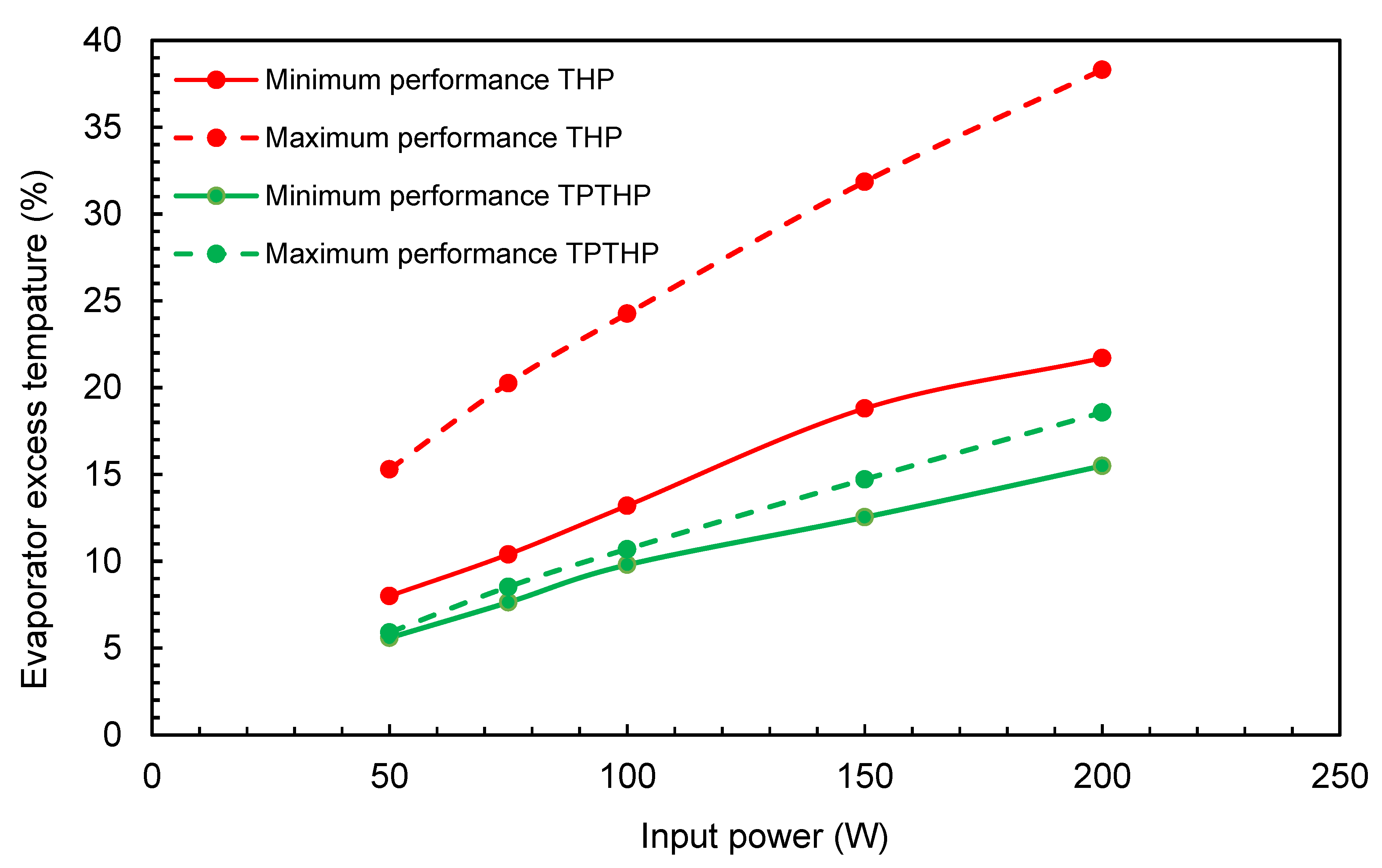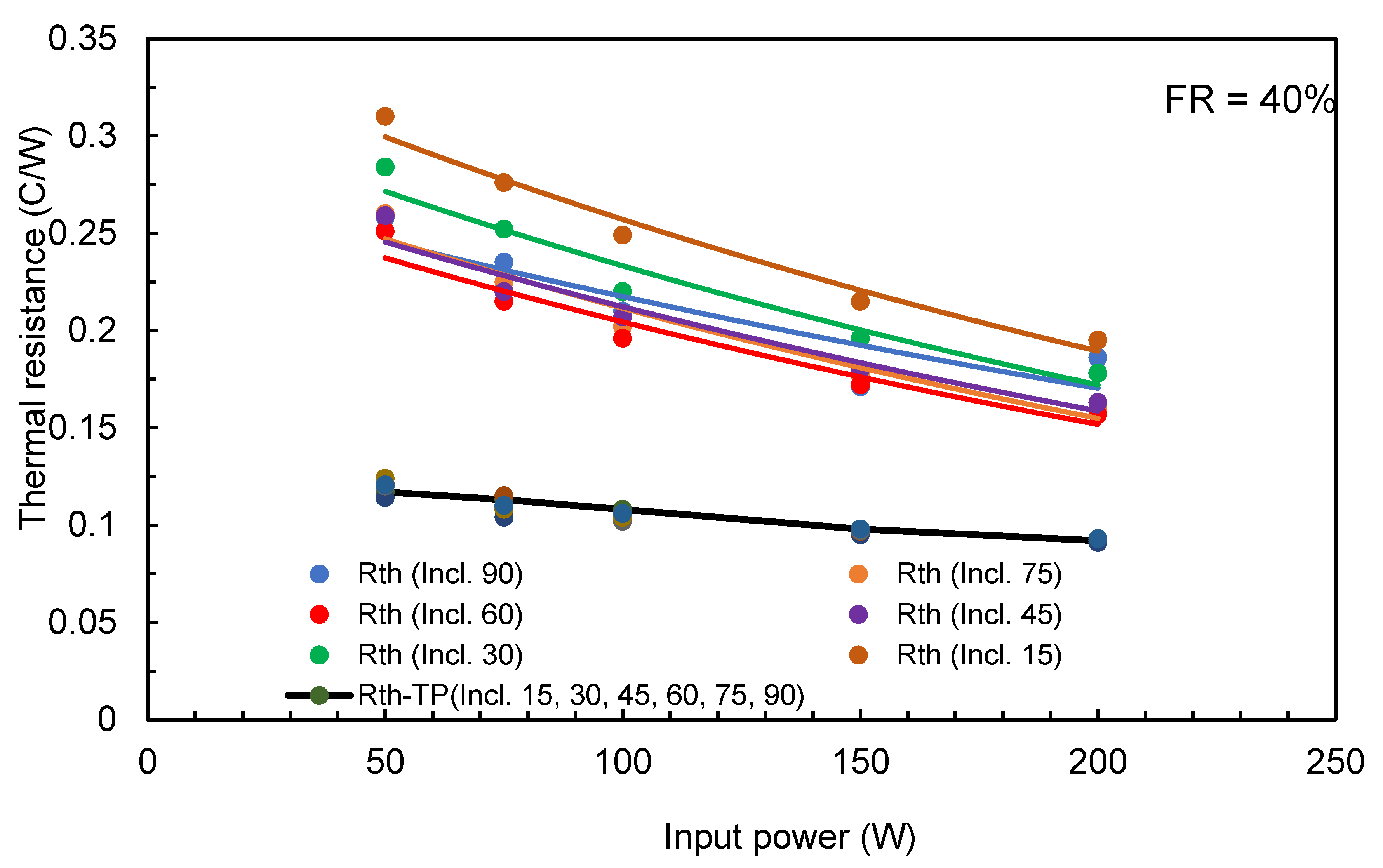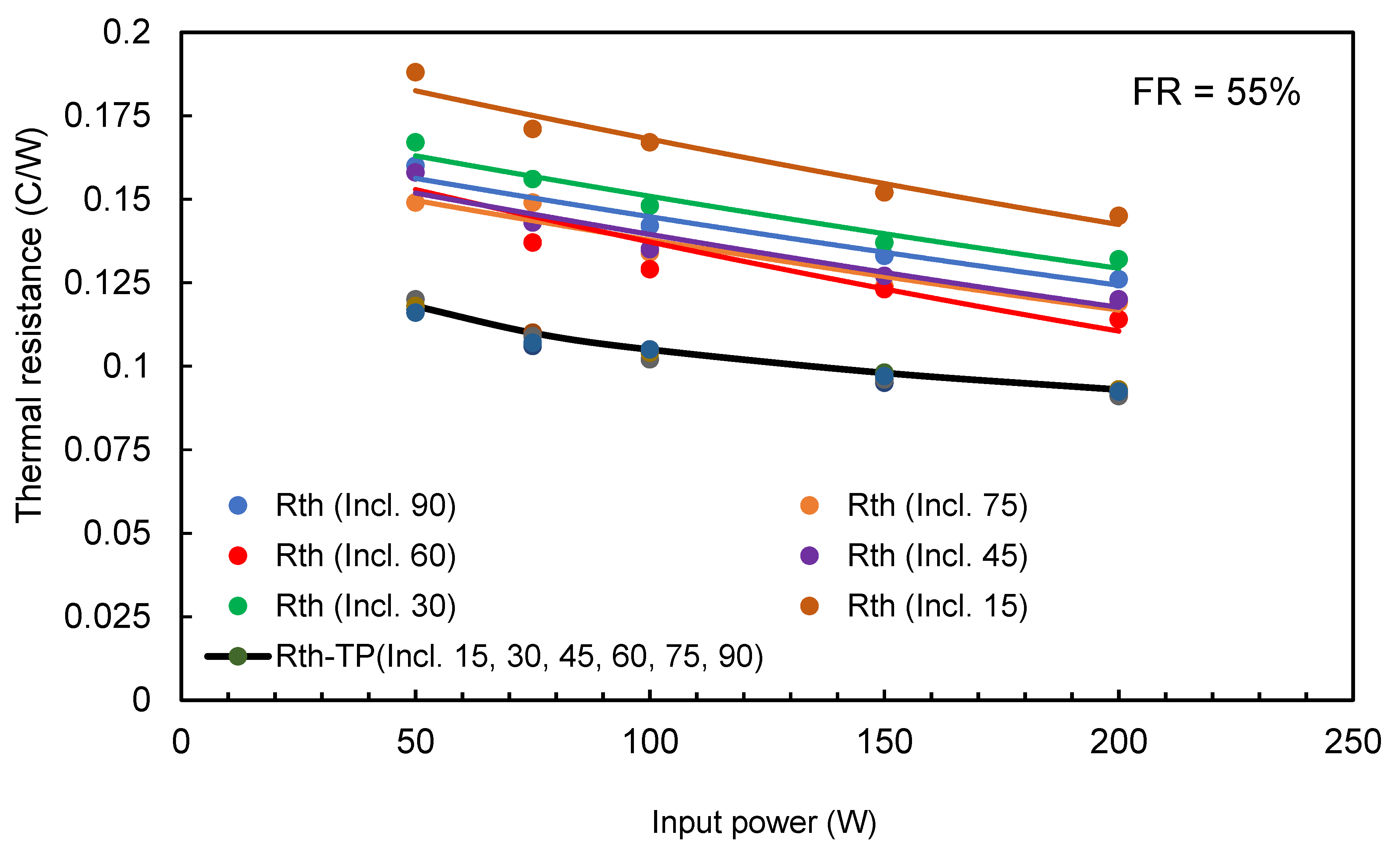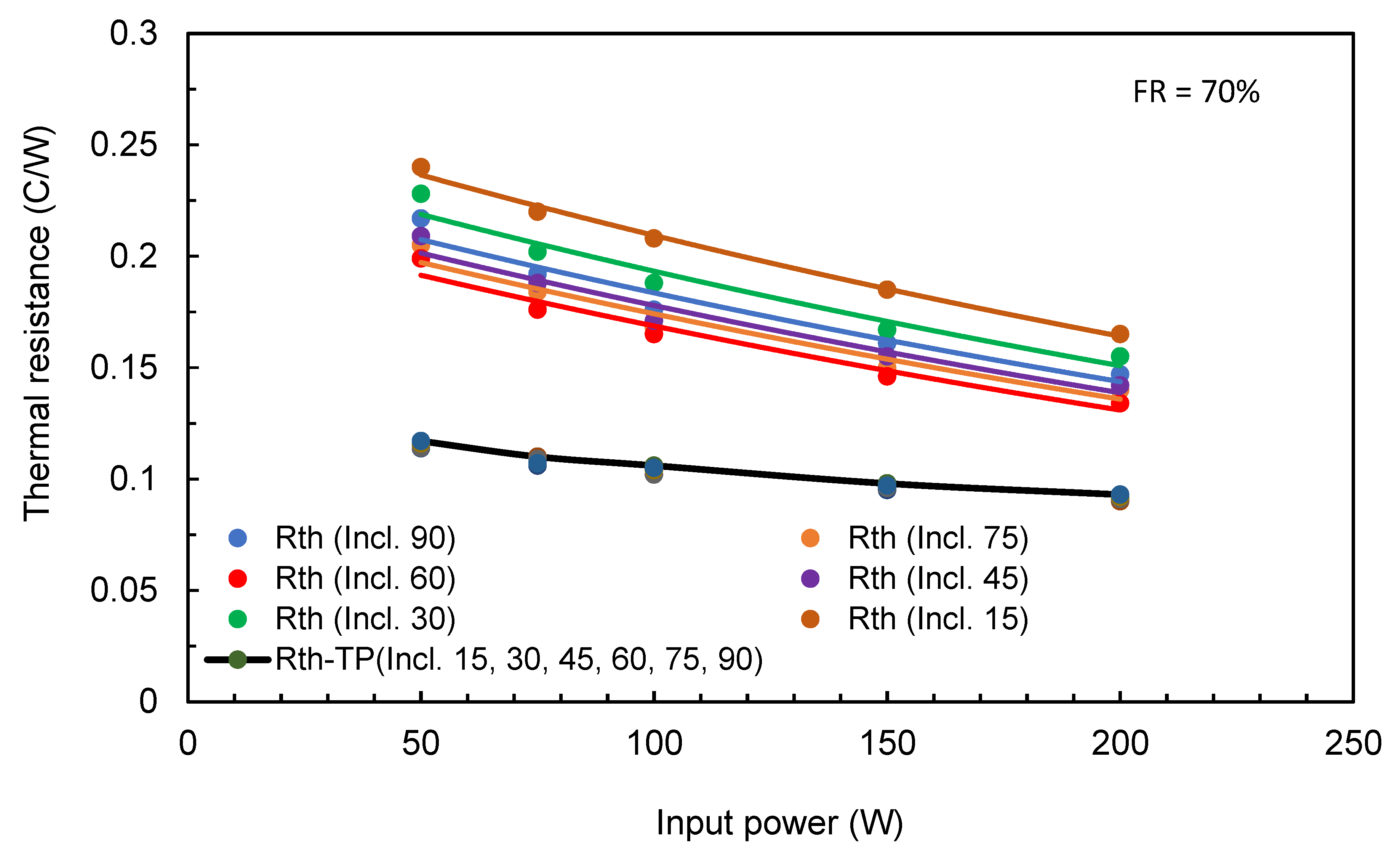1. Introduction
A heat pipe is one of the most efficient and passive heat transfer devices that can transport heat from a source (evaporator) to a sink (condenser) over relatively long distances via the latent heat of vaporization of a working fluid. Heat pipes are used in various applications such as solar and waste material energy devices [
1,
2,
3], cooling of electronic devices [
4], air conditioning applications for building environmental control [
5,
6], space and satellite missions [
7,
8], and thermal management of gas turbine blades [
9]. A heat pipe is a closed pipe with a vacuum that consists of three sections, namely, an evaporator, an adiabatic, and a condenser that is partially filled with a working fluid (de-ionized water was used in this study). A heat pipe functions through cyclic evaporation and condensation of the working fluid that has a low thermal capacitance and low overall thermal resistance; there is no use of pumps.
In recent years, thermosyphon (wickless) heat pipes have been introduced as highly efficient heat transfer devices (thermal super conductors or thermal short circuits) compared to earlier designs which used wick to return the liquid by capillary action from the condenser to the evaporator section [
10]. The amount of absorbed heat depends on the amount of vapor generated and the latent heat of evaporation of the working fluid. At the inner wall of the condenser, the vapor phase changes to the liquid phase. For a straight heat pipe, the condensate returns to the evaporator section by gravity.
A THP is the basic type of heat pipe (HP) upon which all others are based. In order to improve the performance of the THP and ensure its reliability under different working conditions, a number of improvements have been considered to enhance the performance of the simple THP. The main modifications adopted for this purpose are summarized as follows:
- i.
The use of binary mixtures to improve the wettability of used fluids which affect the adhesion and surface tension forces that reduce the entrainment effect during the transit of the two-phases streams inside the THP [
11,
12].
- ii.
The use of PCM-assisted heat pipes for electronic device cooling to enhance thermal performance [
13].
- iii.
The addition of nanoparticles to working fluids to increase heat transfer rates through the THP so it can be used for the high heat flux rates [
14].
- iv.
A geometry modification was also adopted to enhance the performance of THP. The main modification was introduced to the evaporator section by increasing the surface roughness to increase the heat transfer rate by accelerating bubble formation during the boiling process [
15,
16].
The roughness in the evaporator section was increased either directly to the evaporator inner heating walls or by manufacturing the inner evaporator walls from sintered copper particles. The condenser performance was also modified using extensive fins on the heat transfer/cooling walls. Several studies have shown that both techniques enhance the THP [
11,
12,
17,
18,
19,
20].
The principle of the THP performance enhancement used in this work is a novel technique that eliminates the entrainment effect at the interface between the vapor and condensate. It is based on the separation of the vapor streams generated at the evaporator from the condensate stream formed in the condenser. This separation process is performed using a central disk fitted at a certain designed location in the adiabatic section that enables the evaporator and condenser sections to operate separately. This means that the vapor and condensate flows without mixing. Further details of this will be given in
Section 2. A summary of some recent experimental, analytical and CFD publications is provided in the remainder of this section.
Kim et al. [
14] tested the effect of a sintered microporous coating of the evaporator section on the THP’s thermal performance. A copper tube with 25 mm ID, 935 mm length (evaporator: 300 mm, adiabatic: 300 mm, condenser: 335 mm) was tested at both vertical and inclined positions. Water was used as the working fluid for FR in the range of 25–100% and heat flux up to 300 kW/m
2. The results showed that the reduction in Rth values was about 51% at FR 35% and about 30% at FR 70%. The best performance was recorded at an inclination of between 15° and 30° from the horizontal.
Solomon et al. [
21] studied THP thermal performance with and without a thin porous copper coating on the inner surface of a copper pipe. The copper THP had a 16 mm ID and 19 mm OD and a length of 350 mm (evaporator: 100 mm, adiabatic: 100 mm, condenser: 150 mm). The heat supplied was varied in the range of 50–250 W with FR 30% of water at different inclination angles. The thin layer of porous copper was established to enhance pool boiling process and was made using electrochemical deposition process. They also tested the effect of coating with oxides on the thermal performance and found that the copper coat had better heat transfer performance.
Zhu et al. [
4] investigated the geyser boiling inside a glass THP experimentally and numerically. They used an 18 mm ID glass tube with a total length of 500 mm (evaporator: 160 mm, condenser: 180 mm). Heating and cooling were achieved with water heat exchangers with circulation systems. A high-speed camera was arranged to capture the geyser boiling phenomenon inside evaporator section. The temperature distribution results showed good agreement between the CFD simulation and experimental results. The high-speed camera could not capture the geyser boiling, but the simulation provided a good visualization of the phenomenon.
Eidan et al. [
6] investigated the thermal performance of the THP both experimentally and numerically. Six working fluids (water, ethanol, methanol, butanol, acetone, and R-134) were tested using a THP in HVAC systems. The filling ratios varied from 40% to 100% and heat supplied varied from 20 to 200 W. The THP was made from a commercial copper tube with a 16 mm OD and a total length of 400 m. The evaporator length was 150 mm, the adiabatic section length was 100 mm and the condenser section length was 150 mm. Heating and cooling were carried out with hot and cold water jacketed heat exchangers. Water provided the highest thermal performance at a temperature range of 30–50 °C, which is the temperature range of HVAC systems. The agreement between experimental and numerical simulation was within 10%.
Temimy and Abdulrasool [
15,
16] studied the flow pattern of the two-phase flow inside a THP numerically and experimentally. The THP was made from a copper tube with 16 mm OD and had a total length of 600 mm. The evaporator length was 250 mm, the adiabatic section length was 150 mm and the condenser section length was 200 mm. The simulation showed that the flow pattern was a non-steady spatial flow pattern. They also proposed the tube packing (TP) to be inserted into the THP to control the flow streams of steam and condensate. The 3-D CFD results showed that the insertion of the TP produced a uniform circulation of the two phases and enhanced the performance by reducing the R
th of the THP by up to 55%.
Fadhl et al. [
22] simulated a THP under transient and steady state conditions using Ansys Fluent for Refrigerants R134a and R404a as the working fluids at 100% FR with a heat supply in the range of 20–100 W. The THP was made from a copper tube with an ID of 20.8 mm, an OD of 22 mm, and a total length of 500 mm (evaporator: 200 mm, adiabatic: 100 mm, condenser: 200 mm). The simulation results had good agreement with experimental data.
Lips and Lefevre [
23] presented a general analytical solution for the temperature distribution, pressure, and velocity of different HP configurations. Fourier series expansion was used to solve the thermal and hydrodynamic models to find the temperature distribution for multiple heat sources and sinks along the HP. The main conclusion was that this solution can be used to predict the effective thermal conductivity (thermal resistance) of HPs with different configurations.
Alammar et al. [
20] investigated the effect of FR and inclination angle on the thermal performance of THP numerically using a THP with 400 mm length (evaporator: 200 mm, condenser: 200 mm), an OD of 22 mm, and an ID of 20.2 mm. FR varied between 25 and 100% and the heat was supplied at 39, 81, and 101 W. The results showed that the optimum FR was 65%.
Hung and Seng [
24] developed a 1D mathematical model to study the effect of star grooves, cross-sectional area, total length, adiabatic section length, and FR on the heat transfer capacity of a micro HP. The star groove mesh types were triangular, square, hexagonal, and octagonal. They concluded that for thin grooves the heat transfer capacity was increased due to the increase in capillary force. The heat transfer capacity was proportional to the cross-sectional area and inversely to the length of HP. The heat transfer was increased when the adiabatic section length decreased at a constant HP total length.
Nair and Balaji [
17] studied the effect of the insertion of rectangular longitudinal fins (along the condenser section) and the number of fins on the thermal performance of THP numerically. The tested variable as the condensate mass of THP under steady state conditions. The THP was made of copper tube with an OD of 22 mm, an ID of 20 mm, and a length of 500 mm. The evaporator section length was 200 mm and the condenser section length was 200 mm. The fins were attached to the inner surface of the condenser section to increase the effective area for condensation. ANSYS Fluent with a VOF model was used to obtain numerical solution results. Water was selected as the working fluid with FR at 50%. The results were validated with published experimental data for a THP without fins. The results showed that the condensate mass increased by about 22% with eight fins, and by about 32% with 12 fins.
Aswath et al. [
2] used a CFD simulation to compare the heat transfer using water and ammonia in vertical evacuated tubes of solar collectors. A copper tube with a 14 mm ID and 1800 mm length (evaporator: 650 mm, condenser: 200 mm) was used and the FR was set to 100%. They concluded that heat transfer with ammonia was better than water for the same geometry and working boundary conditions. This was attributed to the lower evaporation temperature of ammonia.
Fertahi et al. [
19] established a 2D CFD numerical simulation using ANSYS/Fluent software to simulate a THP for a domestic water heating system. They used a 20.2 mm ID copper tube with a total length of 1000 mm (evaporator: 400 mm, condenser: 400 mm). A VOF model was used with the SIMPLE algorithm for pressure–velocity coupling. A transient solution was used with a 10
−4 s time step. Steady state conditions were reached after a simulated time of 60 s. The results were validated using previous published work and a strong agreement was achieved. The authors suggested that the insertion of tilted fins in the condenser section would enhance the thermal performance of the THP.
This literature review shows that in spite of the extensive studies on heat pipes, there is limited published work on the use of the new internal tube packing (TP). Hence, in this study we aimed to investigate the effect of TP insertion on the thermal performance of heat pipes. Experimental measurements supported by CFD simulation were used to collect data on both the design of the thermosyphon heat pipe (THP) and the thermosyphon heat pipe with tube packing (TPTHP). To achieve the main aim, we carried out the following objectives:
The transient time for the filling ratio was set to 50%, the inclination angle was set to 45° and the input power was set to 200 W.
The temperature of the evaporator, condenser, and adiabatic sections was measured at different input powers of 50, 100 and 200 W.
We examined the effect of inclination angle on the thermal resistance of both designs. Inclination angles of 15, 30, 45, 60, 75, and 90° were used.
We optimized the TPTHP design. The selected upper end elevations of the riser tube were 500, 525, 550, and 575 mm. The selected center risk elevations were 250, 275, 300, and 325 mm. The selected lower end elevations of the downcomer tube were 25, 50, 75, and 100 mm.
We measured the evaporator excess temperature.
We determined the correlation of experimental and numerical simulation data.
3. Results and Discussions
3.1. Initial Data from CFD Simulation
To gain an initial understanding of the physical process inside the THP, the velocity vectors and temperature variation contours from CFD simulation for both THP and TPRHP for vertical case are presented in
Figure 5I–III.
The spatial flow in
Figure 5I appears as complex vortices which can be seen at different locations. The vectors’ behavior presents the variation of local velocity components of the axial velocity (along the THP) and radial velocity. Optimum heat transfer capabilities of the THP occur when the axial velocity is regular and located at the core of the THP [
30,
31,
32,
33]. This is because it will transport the generated steam from the evaporator section to the condenser section regularly. These unfavorable complex vortices will trigger the flooding operation limit which is one of the THP operation limits. The generated steam floods the condensate at the upper region of the THP (condenser section) and prevent it from flowing downward to the evaporator section, so the normal circulation processes of evaporation and condensation will stop, reducing the thermal performance of the THP [
30,
31,
32,
33].
To reduce or eliminate the appearance of vortices, the novel TP is inserted between the evaporator and condenser. The velocity vectors for the TPTHP in the central vertical plane for steady state operation are shown in
Figure 5II. It can be observed that the axial velocity vectors become the main flow vector along the TPTHP. The radial flow almost disappears, except in the zones at the entrance and exit of the PT tube. This flow regularity enhances the evaporation and condensation cycle and enhances the thermal performance of the THP.
To investigate the effect on axial temperature distribution,
Figure 5III presents a comparison between the temperature contours for both designs. It can be observed that the insertion of TP causes a significant difference in the temperature distribution along the axis of the heat pipe. The contours also show that the relatively high temperature zones appear at the upper end of the evaporator section and through the riser tube due to the separation between the condensate and steam. The temperature scales show a lower maximum temperature for the TPTHP compared to the THP.
3.2. Evolution of Temperature in Evaporator, Adiabatic Section and Condenser under Transient Heat Transfer Conditions
The variation of wall temperature with time along the length of the THP at a water filling ratio of 50%, inclination angle of 45°, and input power of 200 W is shown in
Figure 6. As the fluid in the evaporator section is heated, the evaporation process begins and the vapor travels to the condenser due to the density differential. The average evaporator section temperature increases steeply to 73 °C, i.e., it becomes 30% higher than the steady state temperature (56 °C) over 2.5 min. The peak value was due to the accumulation of heat in the evaporator section before the generation of vapor. The formation of bubbles and their size depends on the thermo-physical properties of the working fluid, the nature of the inside surface, and the input energy. As the size of the bubbles increases, the thermal resistance in the evaporator increases and leads to the surface temperature increasing.
As the evaporation and condensation processes continue, the temperature will be decreased. It then increased gradually until both the evaporator and condenser reach steady state conditions after around 16 min.
The adiabatic section temperature behavior was influenced by the evaporator section behavior with a time lag and relatively low temperature. The time lag was due to the time required for heat transfer from the steam to the THP wall by convection and conduction through the THP copper material from the hot wall of the evaporator to the wall of the adiabatic section. The condenser section temperatures increased slowly until steady state conditions were achieved. The average transient operation time is around 17 min. The results from the CFD prediction are included in
Figure 6. It can be observed that there is a strong agreement between the experimental values and predicted values.
Figure 7 shows the average temperatures of the evaporator section, adiabatic section, and condenser section data for both the TPTHP and the THP from the experimental measurements. The data were collected with an FR of 50%, inclination angle of 45°, and input power of 200 W. It can be observed that the evaporator section of the TPTHP has a lower average temperature than the THP, and the increase is not as steep as the THP and the time required to reach the maximum temperature is 1.68 min. This is attributed to the faster circulation of the vapor and condensation. The insertion of TP reduced the maximum temperature of the evaporator section during transient operation by 50% for the tested operating conditions. The average transient operation time was around 11 min compared to 17 min for the THP.
The adiabatic section temperature increased gradually to reach steady state conditions without the peak observed in the THP. The results show that the THP temperature was higher by around 10 °C. The temperature evolution in the condenser was gradual for both designs and the discrepancy was very small between them.
3.3. Comparison of Temperature Variation with the Length of the TPTHP and THP
Temperature distribution is one of the main performance parameters used to evaluate the THP [
34,
35]. As explained in Equation (1), the thermal resistance (R
th) of the THP was calculated from the temperature distribution in the THP.
Figure 8 and
Figure 9 present the measured and predicted temperature distribution for two cases with a filling ratio of 50% and inclination angle of 45 °C for the TPTHP and THP. In general, as the supplied power increased, the temperature increased, and this was more pronounced in the evaporator section. The results showed a good agreement between the experimental measurements and CFD prediction.
Figure 10 presents the temperature distribution for the TPTHP and THP designs. It can be observed that the temperature increased by 20 °C in the evaporator and 4.5 °C in the condenser for the THP, while it increased by 16 °C in the evaporator and 6 °C in the condenser when the input energy increased from 50 to 200 W for the same cooling load. By inserting TP, the new design modified the flow streams for both the steam flowing up toward the condenser section and the condensate descending by gravity to the evaporator section.
Figure 3b represents the flow patterns that exist due to TP insertion. With this design, no interaction between the two phases occurs and each phase flows separately. The main advantage of this design is that the condensate will reach the evaporator at a lower temperature, and this was confirmed by the experimental and numerical simulation results.
3.4. The Effect of Inclination Angle (α) on Heat Pipe Performance
The inclination angle is another important parameter that affects the THP’s thermal performance.
Figure 11,
Figure 12 and
Figure 13 present the variation of thermal resistance with inclination angle for three different filling ratios (40%, 55% and 70%) for the TPTHP and THP. It can be observed that the inclination angle and filling ratio has a non-significant effect on the thermal resistance values of the TPTHP for all cases.
For THP cases, the results show that for a constant heat supply, the lowest thermal resistance is obtained at an inclination angle of 60°. This is due to gravity assisting the liquid flow back to the evaporator. The highest thermal resistance corresponds to an inclination angle of 90°, particularly at lower input power, which may be attributed to the presence of a large amount of liquid in the evaporator. The Rth values decreased when the inclination angle increased from 15° to 60° and decreased when the inclination angle went from 90° to 60°.
The main effect of the insertion of TP was the reduction in thermal resistance and the elimination of the effect of the inclination angle and filling ratio.
3.5. Initial Study on Optimization of TP Dimensions and Location
The advantages of insertion of the TP are as follows: (i) All generated steam flows to the upper end of the condenser without any obstruction, i.e., without flooding; (ii) all of the supplied heat can be absorbed by the evaporator to generate more steam, which means that the cooling ability is increased; (iii) the condensation will start at the upper zone of the condenser section, so the condensate temperature will decrease until it reaches the lower zone of the condenser section; (iv) the relatively cold condensate will flow to the lower zone of the evaporator section and cool the liquid pool, so the temperature difference between the hot source and the liquid will be high, improving the heat transfer in spite of the low average temperature of the evaporator.
Geometry optimization was carried out using the CFD model to identify the most appropriate dimensions to give the best thermal performance of the TPTHP. The optimization was carried out at constant values of FR (50%) and a vertical inclination (90°), with an input power in the range of 50–200 W. The locations of the riser, central disc and downcomer were measured from the end of the evaporator, which is considered the datum for measured height. The riser tube exit was tested at heights of 500, 525, 550 and 575 mm for the central disc at 250 mm and the downcomer at 25 mm. The elevations tested for the central disk were 250, 275, 300 and 325 mm with the riser exit at 550 mm and downcomer exit at 25 mm. The downcomer tube was tested at heights of 25, 50, 75 and 100 mm with the central disc at 250 mm and riser exit at 550 mm. The effect of the locations of these three parameters on R
th values is plotted in
Figure 14,
Figure 15 and
Figure 16. The results indicated that the lowest R
th was achieved with a riser level of 550 mm, the central disk at 250 mm and the downcomer at 25 mm.
One of the main outcomes of this study was that the new design of the TPTHP with TP gives a high reliability in the working of the THP so that it can be used for different applications because the temperature within the TPTHP is limited to relatively low values. In this work, initial testing of the suggested modification was performed to confirm if this was the case, and we carried out further investigation with different fluids and other conditions are to be tested.
Referring to
Figure 3b, the separation of phases was performed and the evaporator was separated from the condenser so that there was no heating of the condensate by the rising steam, resulting in lower temperatures in the evaporator and lower overall temperature yet the same mass could be evaporated for the working fluid.
3.6. Evaporator Excess Temperature
Experimental results from the THP and the optimum design of the TPTHP were discussed in
Section 3.4 and are shown in
Figure 17. It can be observed that the lowest thermal resistance (maximum performance) for both cases occurred at an FR of 55% and an inclination angle of 60°, while the highest thermal resistance (minimum performance) occurred at an FR of 40% and an inclination angle of 15°.
The temperature between the evaporator wall and the saturation temperature of boiling water (estimated from the returning condensate from the condenser) was examined and was within the nucleation regime excess temperature given in the literature [
28]. The results showed a lower maximum temperature in the case of the TPTHP design for almost the same condenser temperature (
Figure 7). The evaporator operated at a lower temperature difference but generated the equivalent effect, q″α (ΔTe)
3.
3.7. Empirical Correlation Based on Experimental Data
The data generated from the experimental measurements for both TPTHP and THP were used to calculate the thermal resistance for different FR ratios, inclination angles, and input power.
Figure 18,
Figure 19 and
Figure 20 present the variation of thermal resistance with input power. It can be observed that the thermal resistance decreased with increasing input power. The results show that the TPTHP were all similar but for the THP there was more variation.
The graphs in
Figure 18,
Figure 19 and
Figure 20 were included in empirical equations to predict the thermal resistance as a function of the inclination angle (α) and input power (IP). For THP, the following formulae can be used for each FR setting:
The results were similar for all filling ratios and inclination angles. However, the results show that the thermal resistance is a function of the input heat. Based on the experimental data from all tested cases for the TPTHP, the following formula for any filling ratio and inclination angle can be used:
Figure 21 presents the estimated R
th from Equations (9)–(12).


